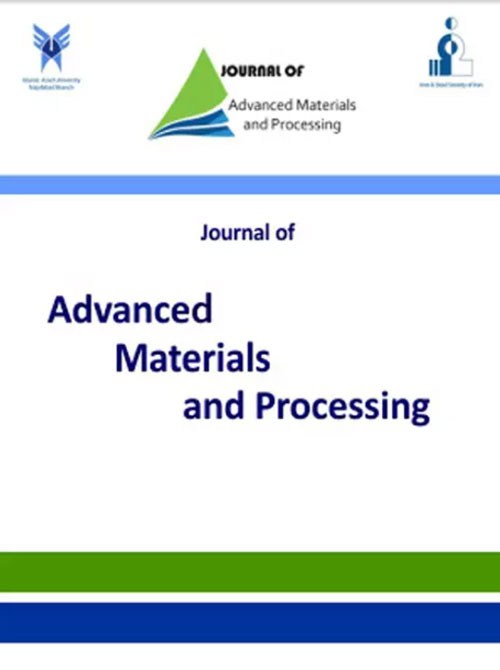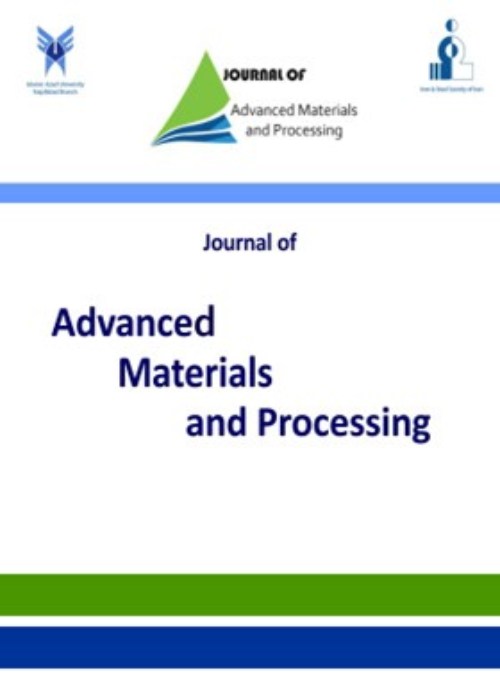فهرست مطالب

Journal of advanced materials and processing
Volume:10 Issue: 1, Winter 2022
- تاریخ انتشار: 1401/06/09
- تعداد عناوین: 6
-
-
Pages 3-12
In this study, ultrasonic bath and milling processes were used to synthesis epoxy resin-multiwalled carbon nanotubes (MWCNT) composite, and their effect on the absorption of magnetic waves was investigated using the Vector Network Analyzer (VNA) test. The effect of the concentration of MWCNT used to attract the wave's magnetic part in the epoxy resin matrix is also investigated. This study showed that the optimal amount of MWCNT in this epoxy resin-MWCNT composite was about 5 wt.% for the ultrasonic bath method, while it was around 15 wt% for the milling method. The ultrasonic bath caused the reflection losses (RL) value reaches to about -25 dB in the range of 9 to 11 GHz. The results of the VSM test showed that the composite produced from epoxy resin and MWCNT is a soft magnetic material. Also, the sample produced in the ultrasonic bath process has a higher magnetic saturation than the milling process, which causes it to absorb more electromagnetic waves.
Keywords: Electromagnetic waves absorption, MWCNT, Epoxy Resin, Ultrasonic, Composite -
Pages 13-26The aim of the present study was to develop synthesize, characterize, and find many applications of functionalized metal oxide nanoparticles. Herein, a new strategy is developed to functionalize magnetite nanoparticles to improve their performances of cerium oxide-functionalized Fe3O4@SiO2@CeO2 magnetic nanoparticles (FSC). In this study, after preparing optimized FSC, characterization and identification of their chemical structure were carried out by FT-IR, FESEM, VSM, TGA, DLS, and XRD. Afterward, the functionalized nanoparticles were examined in the delivery of celecoxib as an active drug model involving cerium oxide and hydroxyl functional groups. The results with respect to particle size, present investigation indicate that the formulations (mFSC=5 mg, pH=3.3) can be considered as best among various formulations. Dynamic light scattering (DLS) techniques used to measure particle size and zeta potential distribution revealed successful preparation of an Fe3O4@SiO2@CeO2 nanocomposite prepared on Fe3O4@SiO2 (FS), with a hydrodynamic size distribution of 45 nm.Keywords: Dynamic Light Scattering (DLS), Magnetite, nanocomposite, Celecoxib, TGA
-
Pages 27-38In this research, a high entropy alloy of AlCoCrFeNiMn is made through mechanical alloying and the spark plasma sintering processes. Ball milling was done at different times of 12 h, 36 h, and 48 h in a cup with a diameter of 20 cm. Ball to powder percent weight of 10:1 was selected. X-ray diffraction patterns indicate the formation of solid solution microstructure after 48 h. The crystal size decreases from 23 to 16 nm with increasing milling time. The lattice strain of the structure increments from 0.3 to 0.68% with increasing time up to 48 h. SEM images clearly show the phenomenon of powder agglomeration and the absence of intermetallic compounds or brittle, complex structures. It is observed that with increasing ball-milling time, homogenization of powders increases, and the body-centered cubic phase is formed in the structure. The mechanically alloyed powders were consolidated spark plasma sintered at 700, 900, and 1000 °C. 50 MPa pressure, argon gas as atmosphere, and ten minutes as sintering time were selected as the sintering process parameters. The X-ray diffraction pattern shows that the structure of consolidated high entropy alloy has face-centered cubic and body-centered cubic phases. After sintering by the spark plasma method, the density of powders was measured by Archimedes’ rules, and the value was determined as 99% of theoretical density. The structure was without porosity. The hardness was measured using the microhardness Vickers test. Loading force was 50 g and loading time was seven seconds. The highest hardness was about 649 HV0.05.Keywords: AlCoCrFeNiMn high entropy alloy, mechanical alloying, Spark Plasma Sintering
-
Pages 39-56The present study aimed to synthesize and characterize diopside (CaMgSi2O6) and wollastonite (CaSiO3) nano-bioceramics via a combination of mechano-chemical and calcination processes. In vitro biomineralization and cell responses of wollastonite and diopside were carried out using simulated body fluid (SBF) for up to 28 days and MG-63 osteoblast cells. Results revealed excellent tissue biomineralization of wollastonite and diopside through generating an apatite-like layer on the surface of nano-bioceramics. Wollastonite and diopside cell responses eventuated non-cytotoxicity by MG-63 osteoblast cells, and their viability and cell proliferation were verified. Results of alizarin red staining and alkaline phosphate enzyme of diopside and wollastonite evidenced great bioactivity and tissue biomineralization with respect to the release of Ca2+ and high absorption related to calcium activity, and high activity and growth of alkaline phosphate enzyme to repair bone tissue of diopside, and wollastonite was enhanced in contact with the MG-63 osteoblast cells. Regarding the addition of Mg2+ into the calcium-silicate network for the chemical stability network to improve biological properties, results of biological assays verified that diopside possessed high biological and cell responses in comparison to wollastonite; and both of them can be suggested as great bioactive and biocompatible candidates for biomedical applications.Keywords: Bioactivity, Biomineralization, Cell responses Diopside, Wollastonite
-
Pages 57-65The effects of adding different nano-MgO dosages (0, 1, 2, 3, and 4 wt.% with respect to cement) on microstructural, compressive strength, and phase evaluation of concrete were investigated. Two different post-treatment conditions with water and CO2 gas were used to study the processing method on the samples. The specimens were characterized via SEM and XRD analysis. The mechanical properties of the samples were also investigated. The results showed that compressive strength significantly improved after the addition of magnesium oxide nanoparticles. However, this improvement was more remarkable in the case of post-treatment with CO2 compared to the samples fabricated with water. SEM results showed that the samples treated under CO2 gas had irregular and needle-like morphology. The samples prepared by normal processing had CaCO3 and SiO2 phases, whereas the ones fabricated under CO2 gas contained CaCO3, SiO2, and Ca(OH)2. With the addition of nano-MgO, the density of concrete decreases in the samples post-treated with water, whereas it increases for the samples post-treatment with CO2 gas. Adding 4 wt.% nano-MgO to concrete and further post-treatment with CO2 for 45 days could increase the mechanical properties from ~ 23 MPa to ~ 55 MPa.Keywords: Nanomaterials, MgO, Concrete, Mechanical Properties
-
Pages 67-76
The effect of hydrofluoric acid (HF) treatment on the corrosion performance of the Mg–Zn–Al–0.5Ca alloy was studied by immersing a specimen in HF solutions for varying lengths of time at room temperature. X-ray diffraction (XRD), scanning electron microscopy (SEM) and atomic force microscopy (AFM) were used to study the evolution of microstructures. In vitro corrosion resistance was assessed using potentiodynamic polarization and a room-temperature immersion test in Kokubo solution. The fluoride-treated Mg–Zn–Al–0.5Ca alloy formed by 24h immersion in HF exhibited a more homogeneous, compact, and thicker (2.1 μm) coating layer compared to the other HF treated specimens in 6, 12 and 18 hours. The corrosion resistance performance of the Mg–Zn–Al–0.5Ca alloy formed by 24h immersion in HF was the best, with a corrosion rate of 2.87 mm/y according to the electrochemical experiment. The mean weight loss of the untreated samples was more considerably higher (up to 2 times) than that of the fluoride-treated alloys, according to in vitro degradation assessments. According to the findings because of its low degradation kinetics and apatite formation ability, the fluoride-treated Mg–Zn–Al–0.5Ca alloy is a promising candidate for biodegradable implants.
Keywords: Magnesium alloy, Corrosion behavior, Fluoride treatment, Surface Treatment, Biocompatibility


